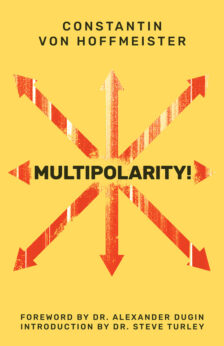The Iranian Theocracy – Myth and Reality
A gloomy picture of Iran dominates the Western media: mass protests against the headscarf, fights between anarchist demonstrators and the morality police, mass executions. Every Iranian, according to the Western narrative, is deep down a Westerner waiting to be ‘liberated’ by George Soros’ NGOs and NATO. Fourty-four years after the birth of the Islamic Republic of Iran, the theocracy is said to be on the verge of its end. But the reality is different, as the Russian political scientist Leonid Savin recently reported: Even in the centre of Tehran, he could see women without headscarves walking unmolested in the streets, cafés, museums, bazaars and parks of the capital at the end of last year. Their hair is black, blonde, but also dyed blue. Some of them even wear piercings and tattoos. Only in the mosque the female gender has to wear headscarves. ‘Let people seek their own way to heaven! We cannot take them to heaven with the power of the whip.’ These words of former president Hassan Rouhani (he ruled from 2013 to 2021) seem to describe the current relationship between state and religion in Iran. Although religion is above politics, which enforces its authority, Shiite Islam is not imposed on the people by brute force.
Iran as a Power Factor: In the Fight against Islamic State and Saudi Arabia, and as a Drone Producer
Apart from the women’s issue, which is of burning interest to the West, Iran has been making a name for itself in recent years, above all in geopolitical terms: since the United States destroyed Iraq under Saddam Hussein in 2003, Iran’s influence in the region has increased noticeably. With help from Tehran, the ‘Axis of Resistance’ was initially established in Iraq, Lebanon and Palestine, which had Shiite militias trained by the Iranian elite troops and political army of the Revolutionary Guards. Iran successively expanded its influence in the so-called ‘Shiite Crescent’, which also angered its declared arch-enemy Israel. Success was not long in coming: in 2006, Hezbollah succeeded in stopping the Israeli army in southern Lebanon and inflicting losses on the Israeli armoured corps. When war broke out in Syria in 2011, Tehran allied with Moscow in 2015 when Assad’s survival was on a knife edge, and began actively fighting Islamic State in numerous ground offensives in the region, while the Iranian Revolutionary Guards were supported by the Russian air force. Iran also intervened in the Yemeni civil war, where the Shiite Huthis are fighting the Saudi Arabia-led government. In 2019, the party it supports managed a spectacular strike with drones against oil production facilities deep in the heart of Saudi Arabia far from the front lines. Immediately, suspicion fell on Iran, which is known to train the militias it supports in drone warfare. Behind many of these developments was General Quassem Soleimani, head of the Revolutionary Guards, who was so hated by US elites that Donald Trump had him assassinated on 3 January 2020. Since then, Soleimani has been revered as a hero by the anti-globalist resistance in many places around the world. But this did not stop Iran in its fight against globalisation. At the latest since Moscow’s replica Shaed-136 kamikaze drones raced into Western guns and tank howitzers on the battlefields of Ukraine, Iran has become an internationally feared military power. Iran, in turn, now wants to strengthen its navy in Russia and have ships built there. But the Iranians are not only able to fight, they were also able to secure their revolution economically.
The Economic Side of the Revolution
Despite Western sanctions, Iran has managed to build up a respectable economy based on the idea of self-sufficiency. The leitmotif of the Iranian economy is moquavemati – resistance. According to this, the social unity of the country and the provision for the poor is the main focus of the economy – only then do the local, regional and national levels come into play; the globalised world economy comes last. Civil aviation includes over 175 aircraft; today the country is one of the ten largest steel producers in the world, valued not only for its oil but also for other mineral resources and minerals. Strong trading partners are China (30% of foreign trade volume), but trade with Africa is also growing strongly. Iran also trades with the US, but this are negligible. While under Rouhani Iran was still very eager for a thaw with the West, in August 2021 Ebrahim Raisi returned to power as a staunch opponent of the US. Accordingly, Iran has little interest in a new nuclear agreement – the US unilaterally terminated the last one under Trump – and the end of sanctions by the West, which is becoming increasingly insignificant economically. Instead, the Iranians’ eyes are turned eastwards towards Eurasia: a free trade agreement covering more than 7,500 goods could be reached at the end of 2022. To connect Russia, Iran and India, there are plans to build an additional railway branch for the North-South Transport Corridor, as well as a canal to connect the Caspian Sea with the Persian Gulf. As we can see, Iran is to be reckoned with in our increasingly multipolar world – in any case as a regional superpower, perhaps even as a pole of power in its own right.







